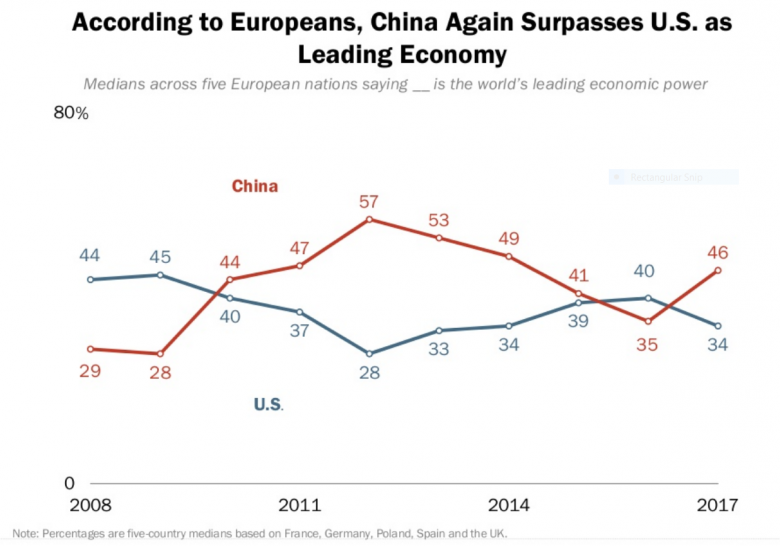Its often hard to convince the owners of product or service brands considering doing business in Asia to embrace WeChat. It can overcome many of the challenges that prevent success in trading in the most important yet complex overseas market.
Back to Top

Why is WeChat important to master?
Trust has become a commodity. A platform of trust drives good economic behaviour in politics, trade and technology. WeChat is such a platform.
Asia is now the world’s 2nd biggest market and fast becoming the more consistently respected economy than USA. But how does your firm access Asia without incurring the risks and costs associated, while overcoming the complexity and distance? WeChat is a stable, secure and ownable channel for any brand or merchant, big or small.
A firm located in Europe or the USA can easily and affordably master it to export products or services cross-border either directly to consumers (B2C), or B2B sectors or verticals – or of increasing interest and value so as to protect and scale your business model – via agents, influencers and experts in-country.
WeChat is a business platform and channel to market, not an app
WeChat is often described as having an “apps-within-an-app” business model. At ACTTAO we call WeChat an OS or operating system.
For anyone not familiar with WeChat here, consider if you were able to rely on a single hybrid app with the best features of WhatsApp, SMS, FaceBook, Twitter, Snap plus PayPal and much more.
For anyone who knows WeChat they will testify to it being a singularly unique business platform. It possesses a deep set of functionality integrated through a simple user interface and doing away with a myriad of individual apps and specialist software we use day to day.
For example, estimates show it has surpassed messaging predecessors and replaced over 80% of email in Asia.
WeChat’s “Secret Sauce”
Wide range of tightly integrated transactional and relational services in one place. +60% of users in Asia access WeChat +10 times every day.
Research shows that WeChat’s tightly integrated stack of services with a wide-ranging set of convenient features including payment, accessed through a simple and unified design, make it successful. Not its chat-based UI (user interface) as many assume.
This is illustrated clearly by the fact that +70% of users in Asia access WeChat +10 times every day.
If we consider WeChat against other mobile app innovations we can highlight its importance in a couple of ways:
- WeChat is a closed channel, not an open social network. It performs really well as a one-to-one direct platform with social sharing features that make it ideal for authenticated and trust-based social eCommerce.
- Emerging as a quasi-competitor to Apple iOS and Android, WeChat has replaced much of the pre-installed functionality of a mobile phone to the point that is effectively device independent.
Frictionless 1:1 engagement through WeChat’s integrated app stack
Extend app-based chat eCommerce into engagement areas such as advocacy (KOL), agent sales (Weishang & Daigou) and CRM
WeChat is unrivalled at personalized eCommerce. As the platform matures, its functionality is being stretched by Tencent further up & down, and now beyond, the traditional customer acquisition funnel. Already 41% of personal care brands in Asia offer a WeChat loyalty programme [Source: L2].
So increasingly WeChat is able to take on a central role for the brand or merchant in fields such as CRM, customer retention, social sharing and advocacy. Examples of these functional sets include:
- Agent referral sales & marketing
- Customer services & returns
- Customer loyalty & redemption
WeChat delivers on a ‘lean’ Asia-entry strategy
A quick ROI is made possible by cross-border eCommerce and customer engagement in WeChat. Leverages personal networks of trust. Ideal for any business model, simultaneously B2B & B2C & C2C. Supports authenticity & verification, integrity & validation, and tracking & traceability.
WeChat is a great communication tool for B2C and C2C so that it drives the conversion of personal chat and social sharing with potential buyers towards deeper engagement and can convert them not just to become customers but retain them as loyal followers. WeChat is one of the few social platforms globally that a brand can manage the customer journey well throughout all stages and move revenue-generating behaviour online to offline, often the opportunity being to use value-add messaging experiences to construct meaningful interaction and engagement.
The customer service element to WeChat has a hub and spoke model with multiple channels or touchpoints – both on and offline – providing, for example, loyalty programs and advocacy campaigns, underpinned by traction and traffic in eCommerce.
Probably of greatest long term interest and value to any brand or merchant, WeChat offers a channel with features that support digital authenticity, real user verification, product and service integrity and validation, as well as tracking & traceability along the supply chain through fulfillment and onto after-sales support.
[Source: ACTTAO. Based on a briefing to Dublin Chamber Commerce @DubCham members and guests].
